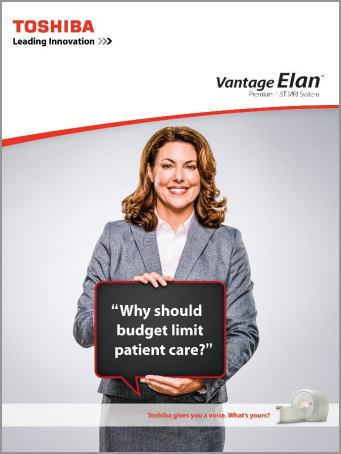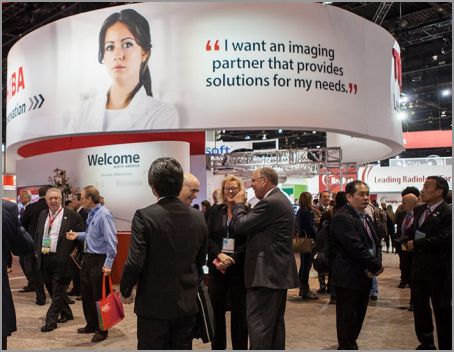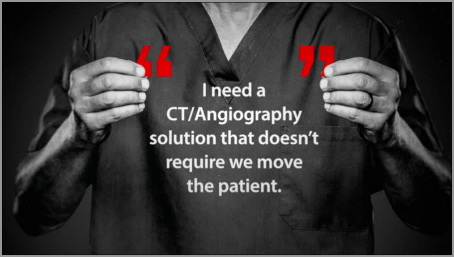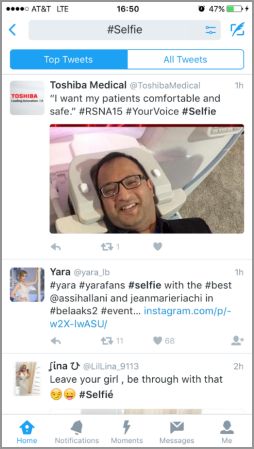by
Courtney Eckerle, Senior Manager of Editorial Content
THE CUSTOMER
Toshiba America Medical Systems provides diagnostic imaging and interventional systems to primarily hospitals and imaging centers.
"The people that we work with, both in the hospital environment and at the imaging center, would be primarily within the radiology and cardiology, the physicians, the clinicians on that side. It could be the techs, so the people who run the systems are called technologists. Sonographers on the ultrasound side," said Cathy Wolfe, Senior Director, Communications and Research, Toshiba America Medical Systems.
Her customers are "the people who make recommendations on equipment, and then because they're very high-dollar purchases, those recommendations go up to someplace in the C-suite, and the C-suite will decide on the actual purchase," she said, adding that the C-suite is most likely a CFO, a vice president or someone heading operations at the hospitals and imaging centers.
CHALLENGE
Toshiba Medical Systems saw the Affordable Care Act being signed into law as a precipitating factor in an already changing market, Wolfe said.
"When your customers' market and business is changing, and for our customers, it changed significantly … your business changes as a provider of products or services to that group," she said.
Wolfe said she and her team knew they needed to change how they reached out to customers, but beyond that, "we needed to do something that was going to be differentiated in our market, but also showed our customers that we really understood their challenges."
This campaign helped her team to deliver both messages to her customers and showed how Toshiba Medical Systems differs in the market. They positioned the brand around delivering the singular message that Toshiba is the only medical imaging company that adapts to you.
CAMPAIGN
This campaign to change brand advertising was launched in November of 2014 at Radiological Society of North America (RSNA), which is the brand's biggest show of the year.
"Our goals were to deliver that message to our customers to ensure they understood how we were different in the market, that we're a company that really works to understand their needs and adapt to those needs, and then also relate to them how it can be helpful to them as they address all of these challenges that they're facing in the market," Wolfe said.
If your customer's business is changing, your business is changing, she added. So her team got to work to address the market in a different way.
They went through several steps of positioning, creating creatives, testing suppositions in the creatives, integrating and measuring how it fit into all the various channels. They then went back to make any changes that needed to be done to consistently evolve for the customer.
"It wasn't an easy transition to make entirely. It was easy in terms of the graphics that we were using, but there was some investment involved. But there are times where you just, you need to make sure that you respond to the market, and respond to all of your stakeholders. So we felt it was that important that we wanted to do that," she said.
Step #1. Conduct a positioning assessment
To start off, Wolfe and her team looked at three factors:
- What was currently being done at Toshiba
- What customers were doing
- What the competition was doing
"We did an assessment basically looking at the competition's advertising, and we found that overall, they had a very sort of similar look, with a lot of blue," she said, adding that creatives often featured people with equipment and some lifestyle photos.
After seeing that, she said, they knew they needed to change more than messaging but the overall brand creatives as well.
Although the decision was made to change the creative significantly, one aspect they decided to keep was the color palette, because, "we were really differentiated on the color palette. We have red, and most of our competition has blue."
To thoroughly back up these changes, Wolfe and her team conducted qualitative interviews with customers.
"We would show people the materials. We did that with a relatively small number of the target audience," she said. Once that was done, and the team ensured they were on track with customers, they went to a quantitative survey online that was sent out to customers in an email.
Step #2. Test creative approaches
With the qualitative research done upfront, the team moved on to assess what was happening in the market and how Toshiba materials compared to the competition. They did this by developing two different creative approaches to the messaging and positioning — that Toshiba is the only medical imaging company that adapts to your needs.
They did this with different visual elements that worked with a quote voicing customer concerns or needs. After testing each of those approaches with customers in both qualitative and quantitative interviews, they landed on what they call a "voice box."

Click to see a larger, printable version of the chart
Toshiba's research showed that four out of five people responded better to this layout than that showing a person's face. They were able to focus on the quote, without distraction.

Click to see a larger, printable version of the chart
"That took the look of what we were going to deliver our message around," she said. "We tested our creative with imaging directors, with radiologists, with cardiologists, and … learned how they felt about the messaging."
Once that was done, she added, her team felt like they were in a good place to bring it to market. But before, "we did that, we made sure that we integrated it across all of our delivery mechanisms. So certainly our advertising changed, but our PR approach changed, our social media changed, the look and feel of our website, all of that changed."
Step #3. Integrate the campaign across all efforts
In every single way that Toshiba reaches out to its audience, this campaign reached them, Wolfe said.
This campaign was launched at RSNA, the largest medical industry trade show of the year, and the team used it as a way to distinguish themselves among all the event social media noise.

Click to see a larger, printable version of the chart
To drive conversations during the event, the voice box creatives with customer quotes were used to get the message across that Toshiba listens to its customers. These were shared by being attached to tweets, or sent out via LinkedIn.

Click to see a larger, printable version of the chart
Customers at the event were also tweeted out using the hashtag #yourvoice, with a quote gathered by staff. Customers were encouraged to take a selfie at the booth, and write their own quote.

Click to see a larger, printable version of the chart
This was used as a way to demonstrate in real time how Toshiba gave customers a voice, letting them experience it firsthand.
Step #4. Strategize including internal audiences
An aspect that is extremely important, Wolfe said, is to make sure that all audiences are on board — internal ones included.
"We spent a lot of time doing research with our customers. We also did internal research," she said.
One thing she would do differently in the future is to segment out the sales department.
"The reason I say that is, sales really has to deliver on the message to the customer. And there was a part of it that they weren't comfortable with," she said, explaining, "In order to focus on the quotes, we wouldn't show the heads of people … and sales was really uncomfortable with that."
Even though Wolfe and her team had the research to back up the focus on the quote, "our sales organization felt it really didn't deliver the message that we wanted, and they had a point in that because if you're cutting off the heads of what's supposed to be your customer, sometimes that looks like you're taking away their voice, which is definitely what we did not want to do."
It's important to have everyone on board, she said. So as they continually transitioned this campaign, the creative moved from a voice box to what they call a "voice bubble."

Click to see a larger, printable version of the chart
"The transition became pretty easy, because in most of our materials, we were focusing on this quote anyway, and a lot of times we didn't have people in it. So it was an easy transition to make from the voice box to the speech bubble," she said.
Toshiba is very committed to integrated communications, she said.
"We were lucky in that all communications functions are within one department, so it makes it a little bit easier for us. But it still requires a lot of discipline and a lot of effort. It impacts us in that . . . if we make a change, everything changes, and we all change together," she said.
It's vital that your organization speak in the same way, she said, and "education has to be a big part of that, and we continue to focus on that as well."
That kind of alignment is so important, she added, because not only are customers seeing this new campaign in tradeshow graphics or online, "but they're hearing the same kind of messages when they meet with a salesperson or an executive, or whatever it could be."
RESULTS
"We will continue to build on this messaging because it really resonates with what we believe about ourselves and the market. We have a good reputation for taking care of customers' needs and being responsive to their needs," Wolfe said.
She and her team haven't decided yet exactly how they're going to evolve the campaign, but currently, are looking at "how can we continue to deliver this message, but freshen it up for today's audience and what we are as an organization today, as well."
As for the success of a campaign of this nature, is really critical to look at how those messages are being carried through on the media or public relations side, she said.
The results this brand campaign saw were that advertising clickthrough rates increased from a 5.14% to a 6.84% average — based on AuntMinnie eBlasts, the top radiology publication. One Toshiba eBlast in particular had the number one CTR for AuntMinnie in 2014.
The launch was also supported through an integrated PR campaign by leveraging Toshiba's CMO. Several in-person interviews were successfully secured, and the launch and CMO media interview coverage resulted in 4.5 million impressions and a 75% penetration rate for the main message of Toshiba putting customers first.
A MarketingSherpa case study covering the social media event marketing aspect of this campaign was
published last year, and featured in a presentation at
MarketingSherpa Summit 2016.
Creative Samples
- Voice box
- Alternate ad
- Event image
- Social Media Creative
- #YourVoice event selfie
- Voice bubble creatives
Sources
Toshiba American Medical SystemsRelated Resources
B2B Marketing 2015: Top case studies reveal how to use data to maximize marketing ROIB2B Content Marketing: 100% increase in lead gen for customer service software companySocial Media Marketing Chart: Engagement and reach of top eight social networksSocial Media Marketing: How New York Public Library increased card sign-ups by 35%















